Analyzing Retail Trends and Business Decisions: A Survey Report
VerifiedAdded on 2024/04/26
|29
|3374
|218
Report
AI Summary
This report analyzes data collected from a survey on customer shopping habits and platform preferences, focusing on the impact of online versus offline retail. The methodology includes questionnaire design, sampling, and statistical analysis (mean, median, mode, standard deviation, correlation coefficient). Graphs illustrate key findings, such as platform preferences, purchasing frequency, and the influence of price. Trend lines project the shift from offline to online shopping over three years. The report also discusses the role of Transaction Processing Systems, Management Information Systems, and Decision Support Systems in business operations, and concludes with an analysis of factors driving the shift towards online retail, including price, offers, and customer reviews. Desklib provides access to similar solved assignments and past papers for students.

Business Decision Making
1
1
Paraphrase This Document
Need a fresh take? Get an instant paraphrase of this document with our AI Paraphraser
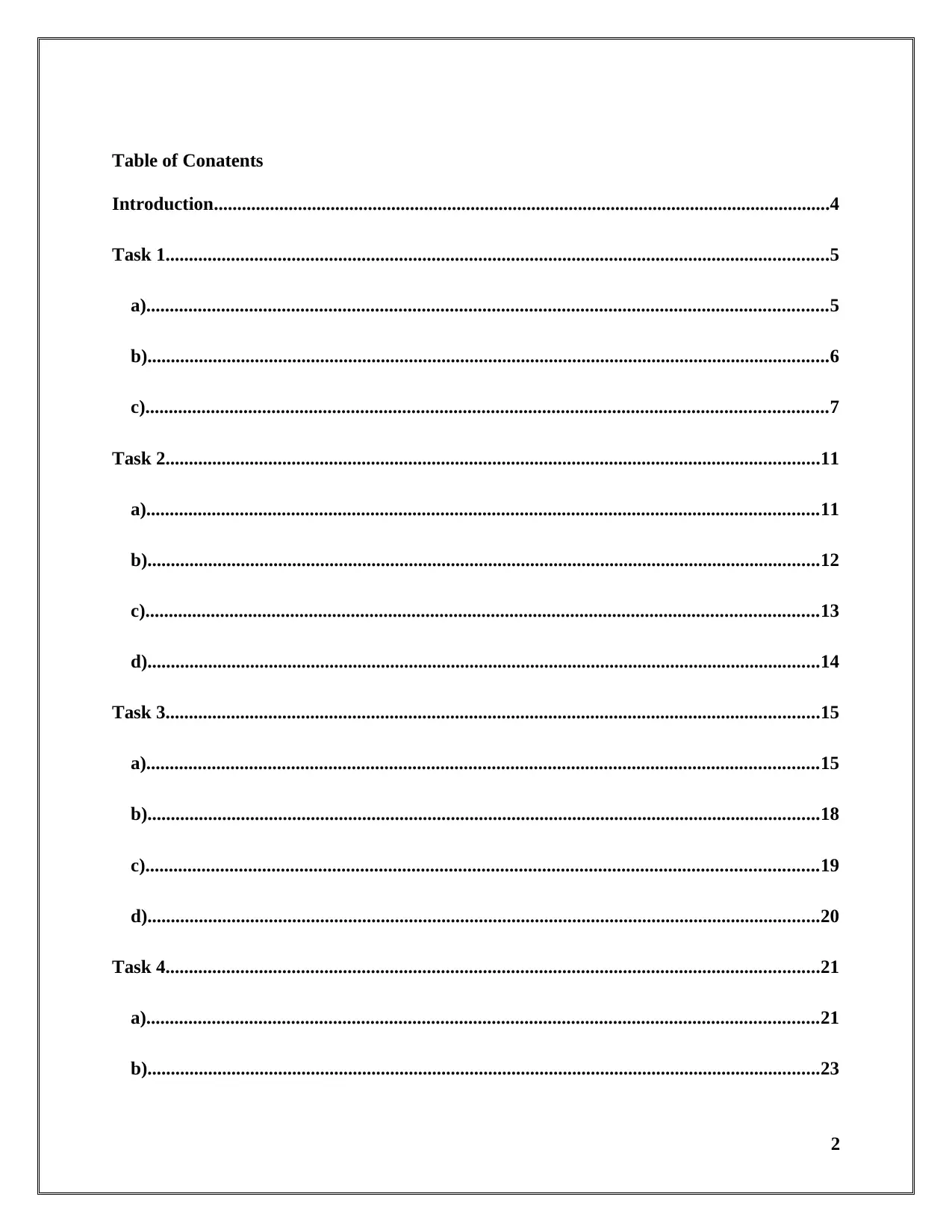
Table of Conatents
Introduction....................................................................................................................................4
Task 1..............................................................................................................................................5
a)..................................................................................................................................................5
b)..................................................................................................................................................6
c)..................................................................................................................................................7
Task 2............................................................................................................................................11
a)................................................................................................................................................11
b)................................................................................................................................................12
c)................................................................................................................................................13
d)................................................................................................................................................14
Task 3............................................................................................................................................15
a)................................................................................................................................................15
b)................................................................................................................................................18
c)................................................................................................................................................19
d)................................................................................................................................................20
Task 4............................................................................................................................................21
a)................................................................................................................................................21
b)................................................................................................................................................23
2
Introduction....................................................................................................................................4
Task 1..............................................................................................................................................5
a)..................................................................................................................................................5
b)..................................................................................................................................................6
c)..................................................................................................................................................7
Task 2............................................................................................................................................11
a)................................................................................................................................................11
b)................................................................................................................................................12
c)................................................................................................................................................13
d)................................................................................................................................................14
Task 3............................................................................................................................................15
a)................................................................................................................................................15
b)................................................................................................................................................18
c)................................................................................................................................................19
d)................................................................................................................................................20
Task 4............................................................................................................................................21
a)................................................................................................................................................21
b)................................................................................................................................................23
2
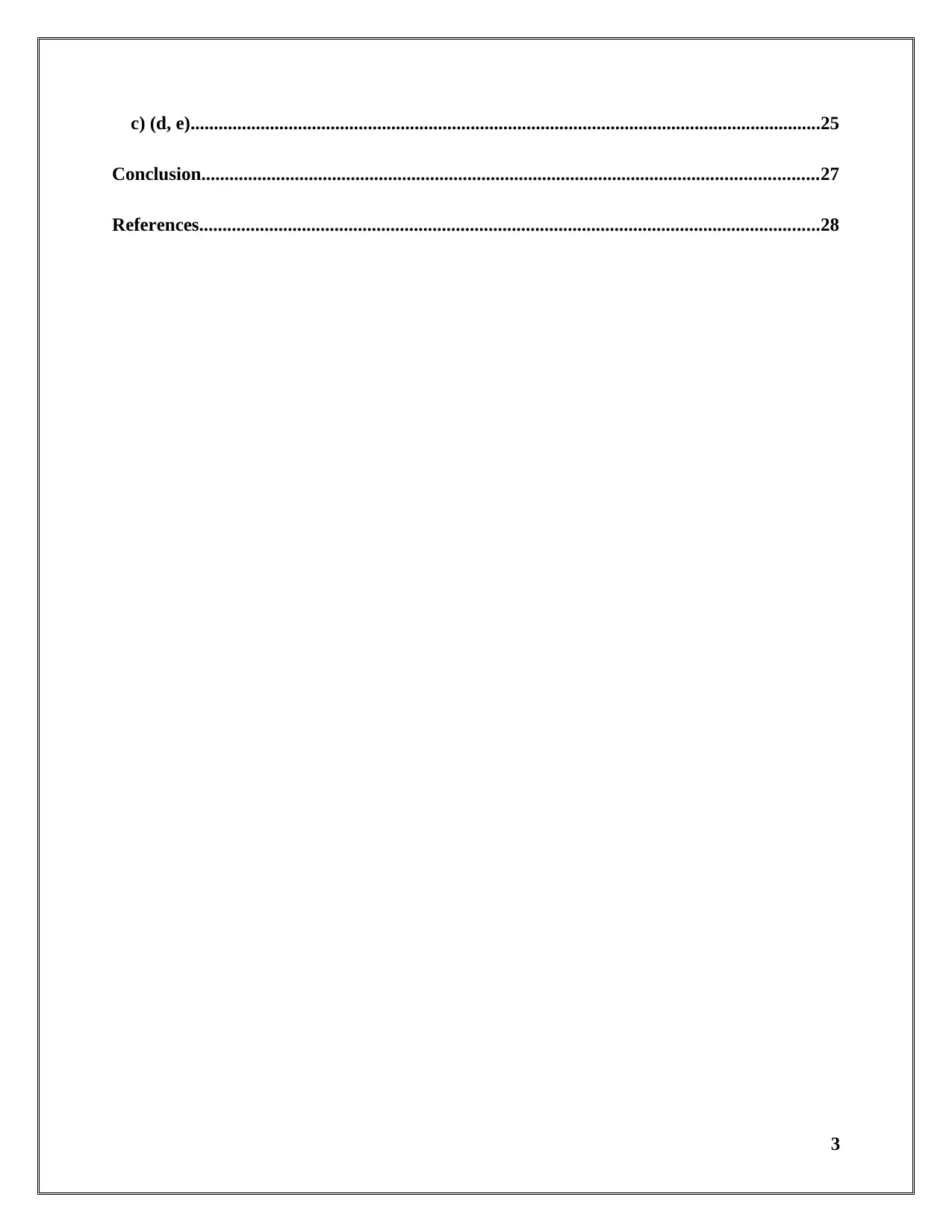
c) (d, e).......................................................................................................................................25
Conclusion....................................................................................................................................27
References.....................................................................................................................................28
3
Conclusion....................................................................................................................................27
References.....................................................................................................................................28
3
⊘ This is a preview!⊘
Do you want full access?
Subscribe today to unlock all pages.

Trusted by 1+ million students worldwide
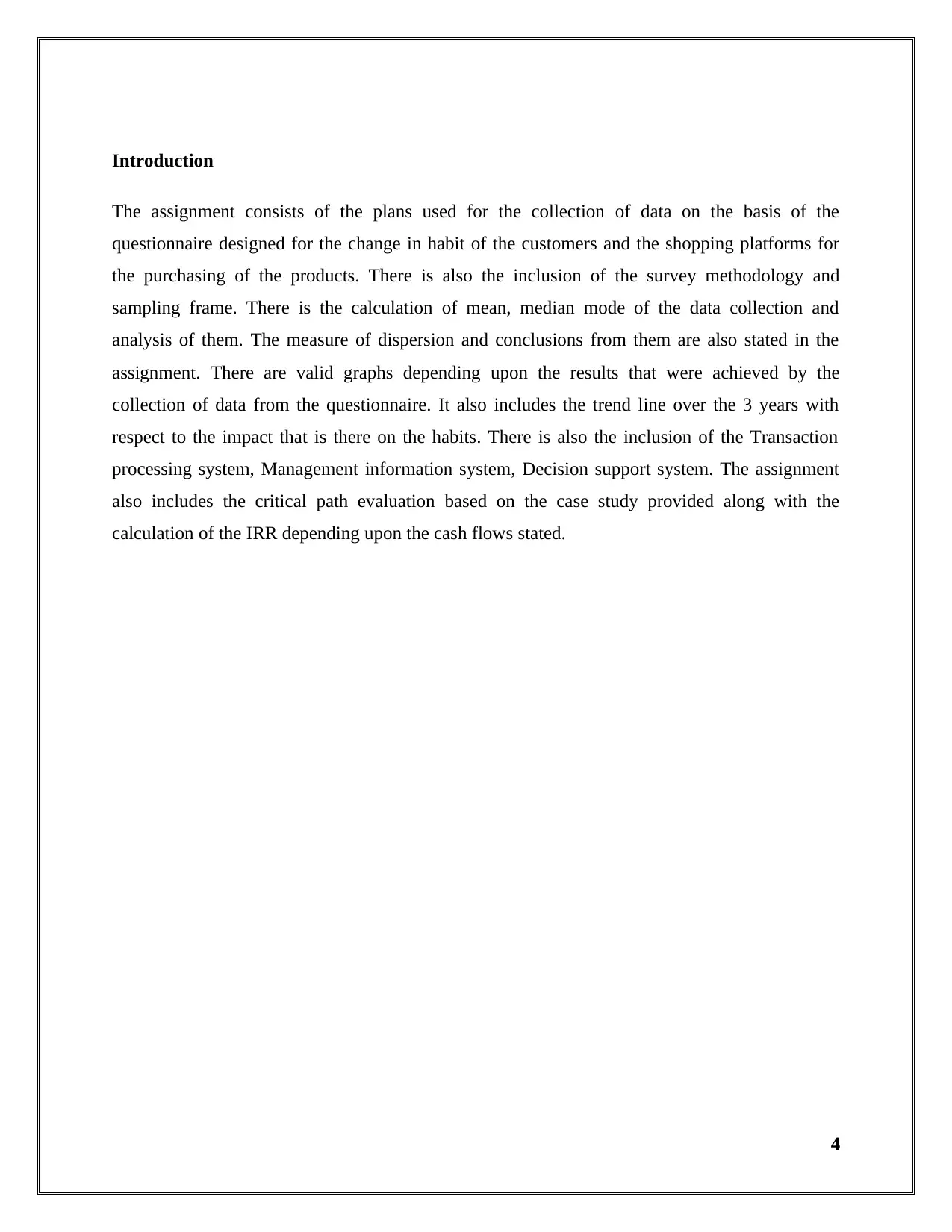
Introduction
The assignment consists of the plans used for the collection of data on the basis of the
questionnaire designed for the change in habit of the customers and the shopping platforms for
the purchasing of the products. There is also the inclusion of the survey methodology and
sampling frame. There is the calculation of mean, median mode of the data collection and
analysis of them. The measure of dispersion and conclusions from them are also stated in the
assignment. There are valid graphs depending upon the results that were achieved by the
collection of data from the questionnaire. It also includes the trend line over the 3 years with
respect to the impact that is there on the habits. There is also the inclusion of the Transaction
processing system, Management information system, Decision support system. The assignment
also includes the critical path evaluation based on the case study provided along with the
calculation of the IRR depending upon the cash flows stated.
4
The assignment consists of the plans used for the collection of data on the basis of the
questionnaire designed for the change in habit of the customers and the shopping platforms for
the purchasing of the products. There is also the inclusion of the survey methodology and
sampling frame. There is the calculation of mean, median mode of the data collection and
analysis of them. The measure of dispersion and conclusions from them are also stated in the
assignment. There are valid graphs depending upon the results that were achieved by the
collection of data from the questionnaire. It also includes the trend line over the 3 years with
respect to the impact that is there on the habits. There is also the inclusion of the Transaction
processing system, Management information system, Decision support system. The assignment
also includes the critical path evaluation based on the case study provided along with the
calculation of the IRR depending upon the cash flows stated.
4
Paraphrase This Document
Need a fresh take? Get an instant paraphrase of this document with our AI Paraphraser
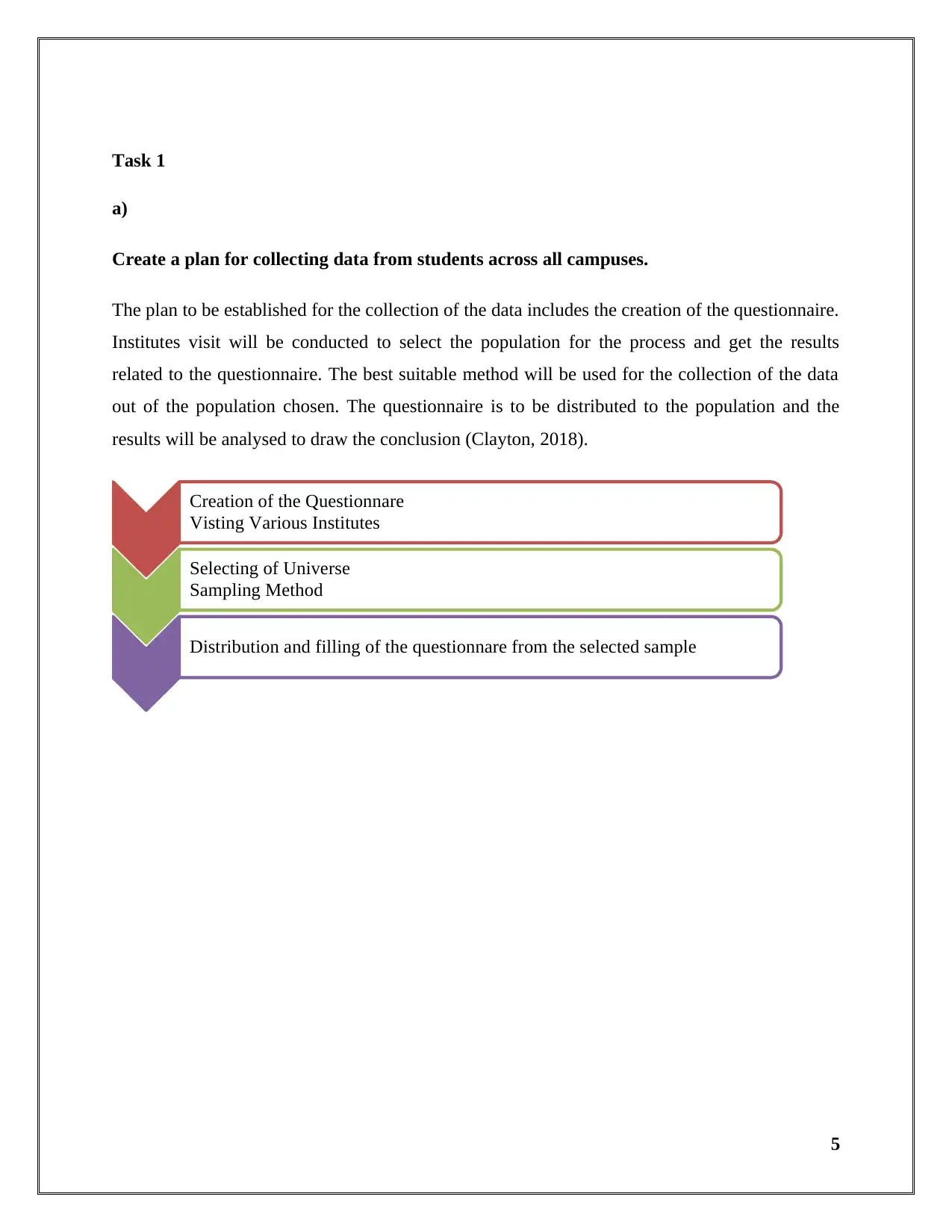
Task 1
a)
Create a plan for collecting data from students across all campuses.
The plan to be established for the collection of the data includes the creation of the questionnaire.
Institutes visit will be conducted to select the population for the process and get the results
related to the questionnaire. The best suitable method will be used for the collection of the data
out of the population chosen. The questionnaire is to be distributed to the population and the
results will be analysed to draw the conclusion (Clayton, 2018).
5
Creation of the Questionnare
Visting Various Institutes
Selecting of Universe
Sampling Method
Distribution and filling of the questionnare from the selected sample
a)
Create a plan for collecting data from students across all campuses.
The plan to be established for the collection of the data includes the creation of the questionnaire.
Institutes visit will be conducted to select the population for the process and get the results
related to the questionnaire. The best suitable method will be used for the collection of the data
out of the population chosen. The questionnaire is to be distributed to the population and the
results will be analysed to draw the conclusion (Clayton, 2018).
5
Creation of the Questionnare
Visting Various Institutes
Selecting of Universe
Sampling Method
Distribution and filling of the questionnare from the selected sample

b)
Present the survey methodology and sampling frame used
There are various methods that can be used for the purpose of the sampling such as Mail Survey,
Telephone survey, and Personal Interview (Research Methodology, 2017). Mail survey refers to
is a self-administrated written survey conducted in case there is large population. The telephone
survey is conducted in a way that the questions are being narrated to the population and instant
feedback is taken. A personal interview is taken face to face in the respondent and series of
questions are asked to the population. The personal interview is considered for the collection of
the data.
The sampling method used by for the determination of the result is a random sampling. Samples
are taken out of the universe instead of conducting it on whole of the universe to generate the
data (Etikan, et. al., 2016). The universe taken for the calculation of the current scenario is of 60
and the population selected was of 40. The conclusions are being determined on the basis of the
results that are being availed from this population size (Singh, and Masuku, 2014).
6
Present the survey methodology and sampling frame used
There are various methods that can be used for the purpose of the sampling such as Mail Survey,
Telephone survey, and Personal Interview (Research Methodology, 2017). Mail survey refers to
is a self-administrated written survey conducted in case there is large population. The telephone
survey is conducted in a way that the questions are being narrated to the population and instant
feedback is taken. A personal interview is taken face to face in the respondent and series of
questions are asked to the population. The personal interview is considered for the collection of
the data.
The sampling method used by for the determination of the result is a random sampling. Samples
are taken out of the universe instead of conducting it on whole of the universe to generate the
data (Etikan, et. al., 2016). The universe taken for the calculation of the current scenario is of 60
and the population selected was of 40. The conclusions are being determined on the basis of the
results that are being availed from this population size (Singh, and Masuku, 2014).
6
⊘ This is a preview!⊘
Do you want full access?
Subscribe today to unlock all pages.

Trusted by 1+ million students worldwide
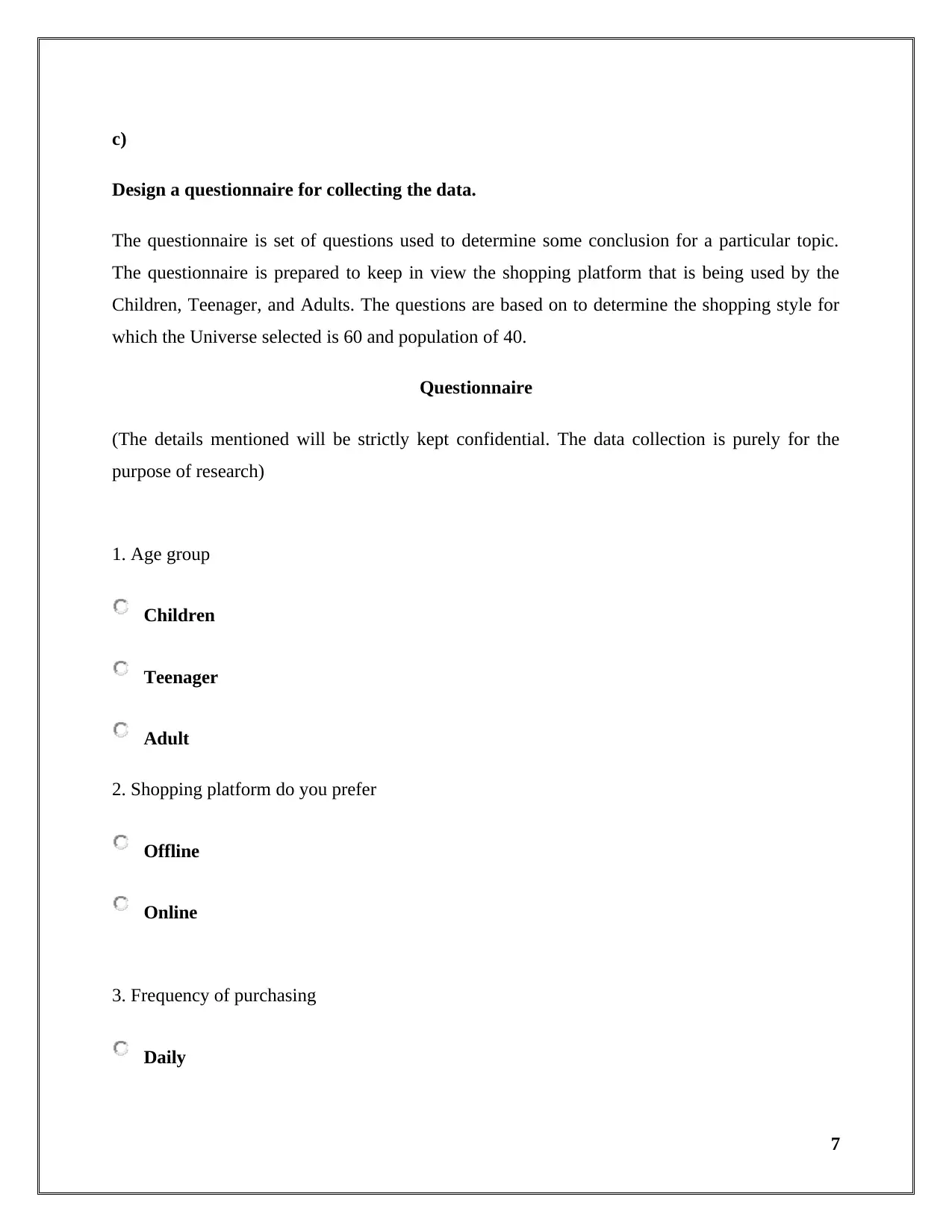
c)
Design a questionnaire for collecting the data.
The questionnaire is set of questions used to determine some conclusion for a particular topic.
The questionnaire is prepared to keep in view the shopping platform that is being used by the
Children, Teenager, and Adults. The questions are based on to determine the shopping style for
which the Universe selected is 60 and population of 40.
Questionnaire
(The details mentioned will be strictly kept confidential. The data collection is purely for the
purpose of research)
1. Age group
Children
Teenager
Adult
2. Shopping platform do you prefer
Offline
Online
3. Frequency of purchasing
Daily
7
Design a questionnaire for collecting the data.
The questionnaire is set of questions used to determine some conclusion for a particular topic.
The questionnaire is prepared to keep in view the shopping platform that is being used by the
Children, Teenager, and Adults. The questions are based on to determine the shopping style for
which the Universe selected is 60 and population of 40.
Questionnaire
(The details mentioned will be strictly kept confidential. The data collection is purely for the
purpose of research)
1. Age group
Children
Teenager
Adult
2. Shopping platform do you prefer
Offline
Online
3. Frequency of purchasing
Daily
7
Paraphrase This Document
Need a fresh take? Get an instant paraphrase of this document with our AI Paraphraser
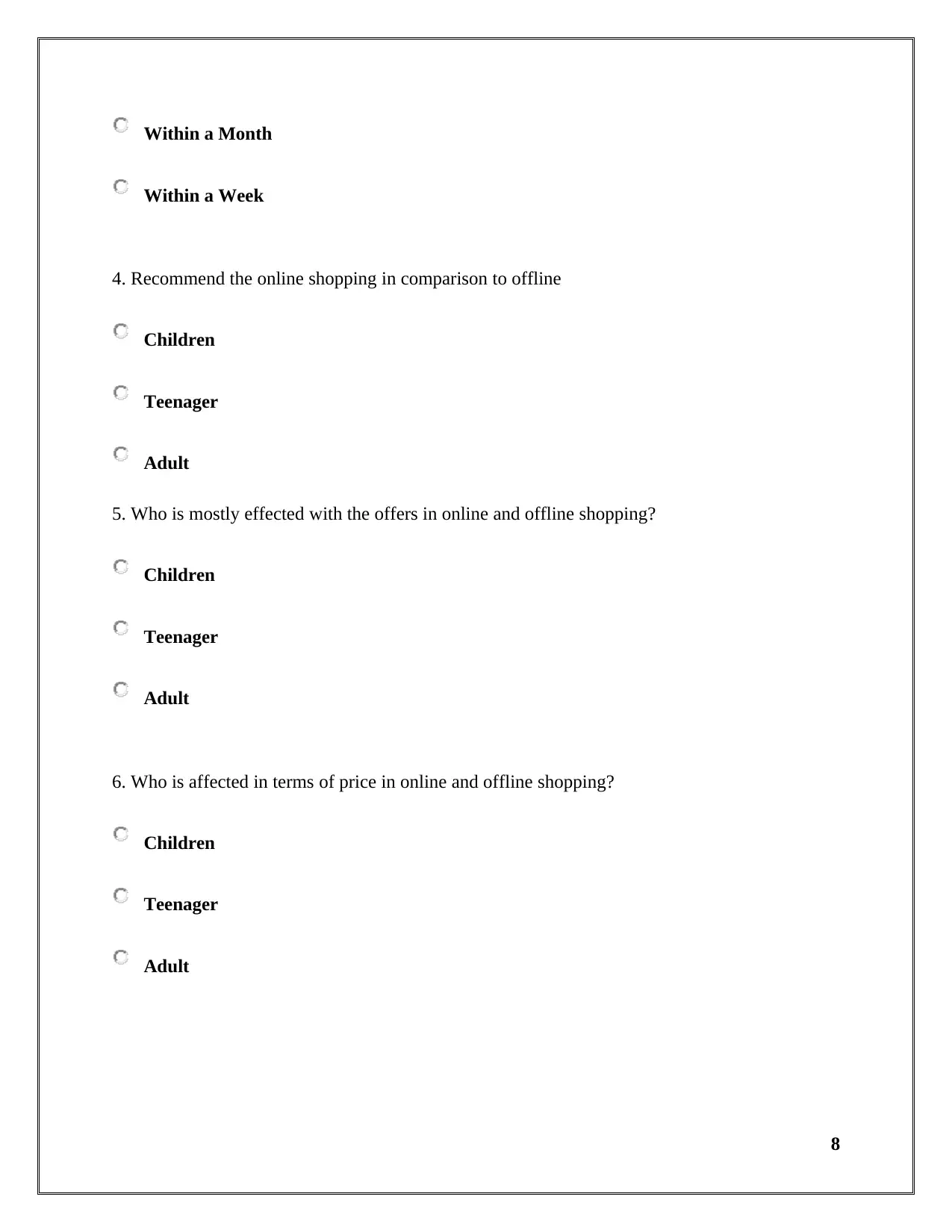
Within a Month
Within a Week
4. Recommend the online shopping in comparison to offline
Children
Teenager
Adult
5. Who is mostly effected with the offers in online and offline shopping?
Children
Teenager
Adult
6. Who is affected in terms of price in online and offline shopping?
Children
Teenager
Adult
8
Within a Week
4. Recommend the online shopping in comparison to offline
Children
Teenager
Adult
5. Who is mostly effected with the offers in online and offline shopping?
Children
Teenager
Adult
6. Who is affected in terms of price in online and offline shopping?
Children
Teenager
Adult
8
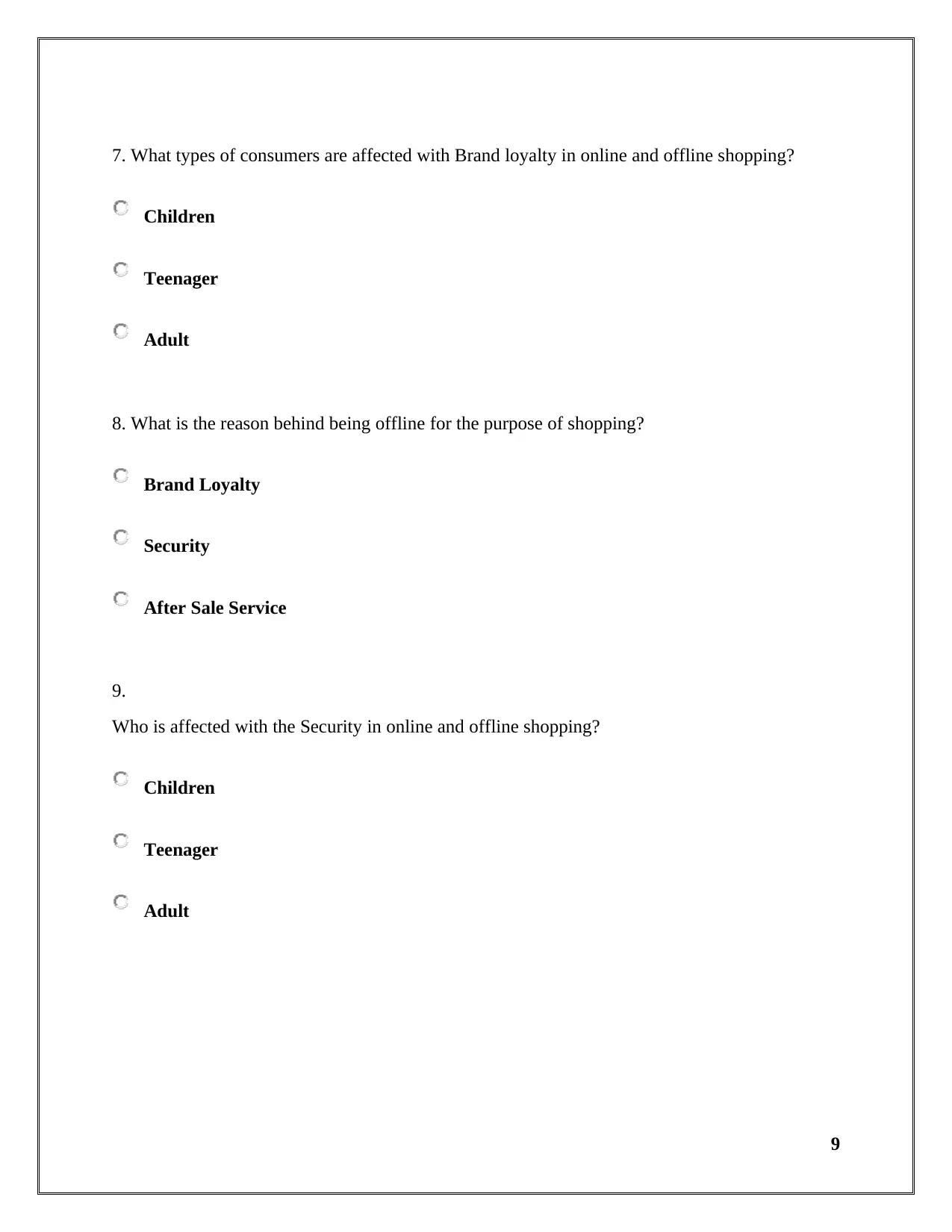
7. What types of consumers are affected with Brand loyalty in online and offline shopping?
Children
Teenager
Adult
8. What is the reason behind being offline for the purpose of shopping?
Brand Loyalty
Security
After Sale Service
9.
Who is affected with the Security in online and offline shopping?
Children
Teenager
Adult
9
Children
Teenager
Adult
8. What is the reason behind being offline for the purpose of shopping?
Brand Loyalty
Security
After Sale Service
9.
Who is affected with the Security in online and offline shopping?
Children
Teenager
Adult
9
⊘ This is a preview!⊘
Do you want full access?
Subscribe today to unlock all pages.

Trusted by 1+ million students worldwide

10. How likely do you promote the online shopping?
Children
Teenager
Adult
11. Online Payment mode used while purchasing on online platform
Children
Teenager
Adult
12. How is your Online shopping experience?
Good
Average
Bad
10
Children
Teenager
Adult
11. Online Payment mode used while purchasing on online platform
Children
Teenager
Adult
12. How is your Online shopping experience?
Good
Average
Bad
10
Paraphrase This Document
Need a fresh take? Get an instant paraphrase of this document with our AI Paraphraser

Task 2
a)
Summarise the data collected from the survey using representative values
Representative value 1 2 3 4 5 6 7 8
Mean 13.3333 15 10.6667 8 8 8.66667
7.6666
7 13.3333
Median 10 15 14 6 6 8 8 14
Mode 10 0 0 0 6 0 0 0
11
9 10 11 12
8.66667 8.66667 4 11.6667
8 6 3 10
a)
Summarise the data collected from the survey using representative values
Representative value 1 2 3 4 5 6 7 8
Mean 13.3333 15 10.6667 8 8 8.66667
7.6666
7 13.3333
Median 10 15 14 6 6 8 8 14
Mode 10 0 0 0 6 0 0 0
11
9 10 11 12
8.66667 8.66667 4 11.6667
8 6 3 10
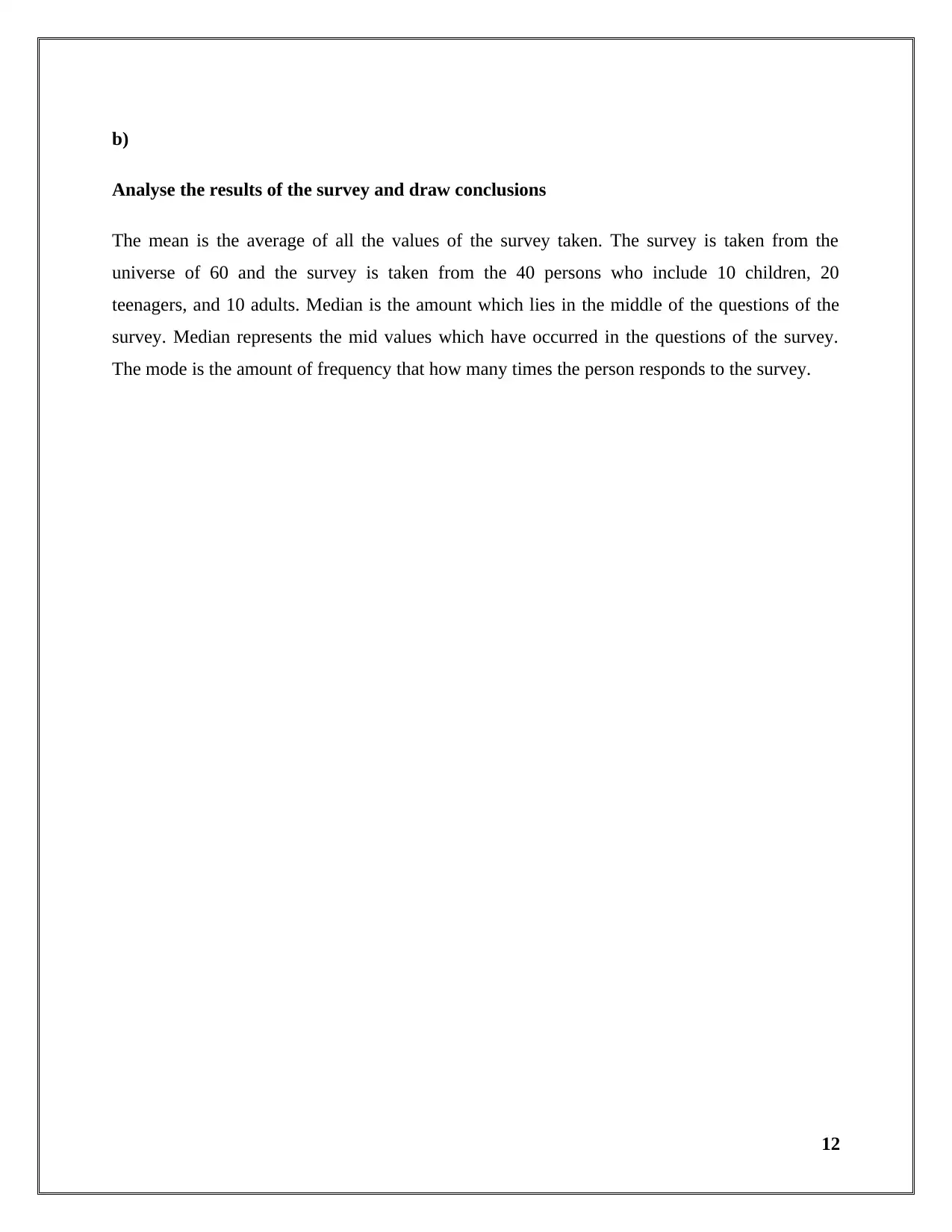
b)
Analyse the results of the survey and draw conclusions
The mean is the average of all the values of the survey taken. The survey is taken from the
universe of 60 and the survey is taken from the 40 persons who include 10 children, 20
teenagers, and 10 adults. Median is the amount which lies in the middle of the questions of the
survey. Median represents the mid values which have occurred in the questions of the survey.
The mode is the amount of frequency that how many times the person responds to the survey.
12
Analyse the results of the survey and draw conclusions
The mean is the average of all the values of the survey taken. The survey is taken from the
universe of 60 and the survey is taken from the 40 persons who include 10 children, 20
teenagers, and 10 adults. Median is the amount which lies in the middle of the questions of the
survey. Median represents the mid values which have occurred in the questions of the survey.
The mode is the amount of frequency that how many times the person responds to the survey.
12
⊘ This is a preview!⊘
Do you want full access?
Subscribe today to unlock all pages.

Trusted by 1+ million students worldwide
1 out of 29
Related Documents
Your All-in-One AI-Powered Toolkit for Academic Success.
+13062052269
info@desklib.com
Available 24*7 on WhatsApp / Email
![[object Object]](/_next/static/media/star-bottom.7253800d.svg)
Unlock your academic potential
Copyright © 2020–2025 A2Z Services. All Rights Reserved. Developed and managed by ZUCOL.





